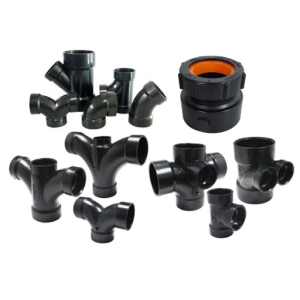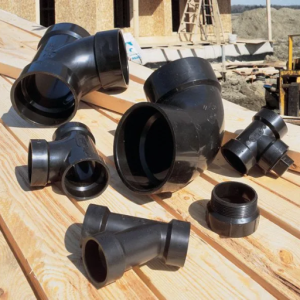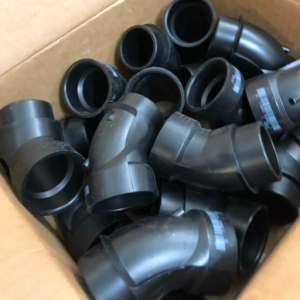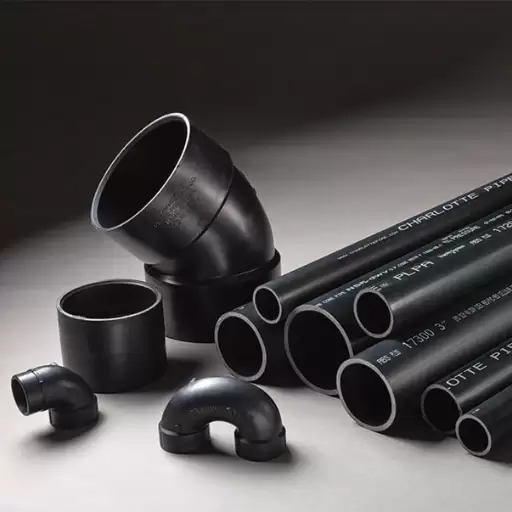This guide will cover ABS pipe fittings on a broad scale, which will help you see why they are essential in plumbing and construction. ABS fittings are highly recognized for being durable, lightweight, and corrosion-resistant; hence, they are used mainly in drainage systems and ventilation, among other fields. As we go through the necessary things about ABS pipe fittings, such as their types, installation procedures, and good points associated with them, you shall have a clearer understanding of why these fittings would be a good option for professional plumbers or DIY.
What Are ABS Pipe Fittings?

Image source: https://www.charlottepipe.com/
These components are made from acrylonitrile butadiene styrene, one of the strongest plastics. They are recommended for use where any type of ABS pipe must join up or terminate. They come in different forms, including elbows, tees, and couplings; you can use them when constructing residential or commercial drain systems.ABS pipes feature resistance against shock, low-temperature effects, and corrosion, lasting longer under harsh working conditions.
Understanding ABS Pipe Fittings
ABS pipe fittings are vital components in plumbing systems and are known for their lightness and strength. ABS fittings are often utilized in drain-waste-vent (DWV) systems because they are very resistant to corrosion or impact, making them suitable for different environmental conditions. During installation, ABS fittings typically utilize a solvent cementing process, which produces a water-tight, durable joint. Compared to other materials, such as PVC, ABS has better shock absorption capabilities and is generally easier to install, hence being of great value to both professional plumbers and DIY enthusiasts. The ease of maintenance and low-cost advantage further make ABS fittings favorable for residential and commercial plumbing applications.
Types of ABS Pipe Fittings
As I look at the various types of ABS pipe fittings available, I see their shapes and functions can mainly classify them. The most popular ones include:
- Elbows: They allow the system piping to change direction with options like 90 degrees or 45 degrees.
- Tees: These join multiple fluid flows together since they make it possible for pipework to branch out.
- Couplings: Simple designs connect two parts of a pipe together so that there is no break in flow.
- Caps: These end pieces help prevent unwanted flow by stopping the passage inside pipes.
- Adapters: Such devices facilitate the easy switching between dissimilar substances used in plumbing, such as PVC and ABS plastics.
Understanding these different kinds now allows me to decide what would be best when contemplating installations or repairs related to plumbing systems.
Advantages of Using ABS Pipe Fittings
Several benefits make ABS fittings a popular choice for many plumbing applications. Some of these advantages are:
- Durability: ABS is renowned for being less prone to physical stress damage than other materials in terms of strength and resistance to impact. This makes it more durable and, hence, longer-lasting in plumbing systems.
- Lightweight: Compared to other piping materials, ABS fittings are lightweight, making handling and installing them easier and reducing the efforts related to their transportation and fixation.
- Cost-Effectiveness: ABS fittings are generally cheaper than PVC or metal alternatives, so they can be regarded as cost-friendly for both large projects and minor repairs. Additionally, their long-term reliability also helps save costs by reducing frequent replacements.
- Chemical Resistance: ABS can resist a wide range of chemicals, making it suitable for various plumbing applications, such as those with tough substances.
- Easy Installation: Using solvents like cementing to join fittings made from ABS is easy because it requires few specialized tools, making it possible even for amateurs.
- Quiet Operation: Pipes made from ABS material tend to reduce noise produced by water flow. This is crucial in places where installations are usually made within residential settings.
Together, these increase the attractiveness of this type of pipe fitting system to customers, thus increasing its acceptance as a reliable component for all plumbing needs.
How to Install ABS Pipe Fittings

Installing ABS pipe fittings is not a tough process; it can be done using simple tools and materials. Below is a brief guide to help you through the installation.
- Choose Tools and Materials: You will need an ABS pipe, fittings, a tape measure, a saw (ideally a pipe cutter), sandpaper, and ABS solvent cement.
- Measure and Cut: Mark the required length of the pipe on it. Use the saw to cut the pipe exactly right-angled while ensuring that its ends are smooth as well as lacking burrs.
- Prepare the Fittings: Lightly rub the edges of both pipes and the inside of joints to improve the bonding surface for solvent cement.
- Use Solvent Cement: For best results, apply ABS solvent cement uniformly on both ends of your pipe and inside of your joint according to the manufacturer’s instructions.
- Put Together Different Parts: Insert your tube into this conduit fast, turning gently around to ensure an even distribution of glue. Hold them together for a few seconds so that they firmly fix each other.
- Allowing Time To Cure: Check with the manufacturer concerning curing time; usually, couplings must be left undisturbed until complete drying before carrying out pressure tests or checking up leaks.
Following these steps will help you install ABS pipe fittings effectively.
Preparing the ABS Pipe and Fittings
To establish a firm and lasting attachment, it is essential to thoroughly prepare both the pipes and fittings to install ABS pipe fittings. First, visually inspect the ABS pipes for any visible damage, ensuring no cracks or defects. Wipe these surfaces using a neat, dry cloth to remove dirt, dust, and grease.
After that, roughen the surfaces of the pipe ends and fittings by scratching them lightly with sandpaper to enhance the adhesion of solvent cement. Cut the pipe according to exact measurements so as not to cause unnecessary bends or pressure points in the system. Finally, smooth out all edges at the ends of your fittings and pipes; otherwise, sharp corners will hinder proper bonding. Lastly, assemble all materials required for installation before you commence so that it becomes easy.
Using Solvent Cement for ABS Pipe Fittings
When applying solvent cement on ABS pipe fittings, I always use it in a well-ventilated area while putting on gloves and goggles for safety. First, check whether both pieces have been adequately cleaned and prepared. Then, generously apply solvent cement on the tube’s outer edge and the fitting’s inner rim, ensuring that all exposed areas are covered to bond effectively together. At once, turn this slightly, thus pushing the tube into the fitting, providing an even layer of cement across its entire length. The first set should be held for about 30 seconds before being allowed to cure according to the manufacturer’s instructions. This approach has consistently resulted in secure and reliable connections for my plumbing projects.
Common Mistakes to Avoid During Installation
- Insufficient Preparedness: One of the most common errors is neglecting to sufficiently cleanse and prepare pipe and fitting surfaces before applying solvent cement. Dirt, moisture, or grease may compromise bonding strength.
- Excessive Solvent Cement Usage: Although applying enough cement is essential, too much can cause oozing, which weakens the bond. Covering the surfaces with just enough cement without excess flowing over is necessary.
- Cure Time Neglect: Rushing through installation and failing to allow for cure time might undermine the connection’s integrity. Always adhere to the manufacturer’s recommended curing time for a strong, lasting bond.
Awareness of these pitfalls can help make the installation more successful and have a reliable plumbing system.
What Are the Different Types of ABS Pipe Fittings?

Different types of ABS (Acrylonitrile Butadiene Styrene) pipe fittings are specifically made for various applications in plumbing systems. Some popular types include:
- Elbows: They change the direction of pipes as they are primarily available at 45-degree angles or 90-degree angles
- Tees: A kind of connector that allows making connections in multiple directions, usually having one inlet and two outlets or vice versa
- Couplings: These are used to connect two lengths of pipe as either straight coupling or reducing coupling
- Adapters: They permit joining ABS piping with other materials and also facilitate changes in pipe size
- Caps and Plugs: These parts are used for closing off endpoints on pipelines; caps cap off a pipe end while plugs seal threaded ends
Each type of fitting is essential for an effective plumbing system that works well, considering its flexibility during design and installation.
Elbows and Adapters
Elbows and adaptors are very important in plumbing systems to enable proper liquid flow and adjust to different setups. Elbows can be bought at specified angles, such as 45 or 90 degrees, which allows them to change the direction of pipes without interfering with the whole system. They are useful in circumventing obstacles and enabling pipe alignment in narrow corridors.
Adaptors, on the other hand, link ABS pipes to materials like PVC or change between varied pipe dimensions. These joints are commonly made with diverse variations, including male/female connections, thereby promoting their compatibility within a prevailing plumbing structure. Elbows, together with adapters, promote the versatility and efficiency of plumbing that also maintains good fluid dynamics.
Tees and Wyes
Tees and wyes are fittings used in plumbing where they help branch off pipes. The three intersecting pipes make a T-shaped junction using tees to connect one main line with two others if I need to redirect flow or create a split in my pipeline. However, wyes perform the same function but with a more gradual changeover. Essentially, they allow a branch line to be converted into a more extensive line at an angle, which reduces turbulence while maintaining reasonable flow rates. Consequently, using such joints lets me control how fluids move throughout my plumbing system for optimal performance.
Couplings and P-Traps
Couplings are essential plumbing fittings for joining two pipes together, ensuring a tight joint and no leaks. They can be designed to extend a pipeline or change its direction, like slip or thread. They connect pipes of different diameters as well as the same ones, which makes them very helpful in plumbing repairs and installations.
However, P-traps are used to prevent sewer gases from leaking into living areas of buildings. They do this by keeping little water in the trap bend to create a closure that hinders gasses while permitting wastewater to flow through the drainage system. They are generally located under sinks, bathtubs, and other fixtures; hence, P-traps play a significant role in upholding hygiene conditions within our plumbing systems. In both cases (for instance, couplings or p-traps), sound installation and regular maintenance are necessary for running your plumbing system effectively, efficiently, and healthily.
How to Choose the Right ABS Pipe Fittings

Some factors need to be considered when looking for appropriate ABS pipe fittings. First, one should consider the specific project requirements, such as the diameter of the pipes and the type of connections needed. Moreover, ensure that these fittings are compatible with existing plumbing not to compromise its performance. On top of that, whether these devices would serve drainage purposes or venting needs such as water supply, among others, should be considered. Also, verify their quality plus resilience, going for reputable brands providing solid materials. Finally, take note of local building codes and regulations when choosing ABS pipe fittings for your undertaking so as not to run afoul of any laws regarding construction procedures during selection.
Considering Pipe Size and Specifications
When choosing ABS pipe fittings, one must consider both the pipe size and the specifications to ensure that it is compatible and functional. It is essential to have matching pipe diameters as this will allow fitting to suit well to create rigid, non-leaky joints. For the right fitting choice, measure the pipe’s outside diameter. Besides, details on pressure ratings and temperature tolerances are also necessary to determine if such fittings can withstand what they could be exposed to. According to top-notch plumbing websites, using those that meet ABS material ASTM standards for strength and performance guidelines is advisable.
Selecting the Appropriate Fitting Type
When selecting the correct type of fitting for my ABS piping project, I first consider whether it is about drainage, venting, or just connecting to water supply systems. From my findings from reliable plumbing websites, I make sure that I select quality fittings designed for specific purposes that would extend their lifespan as intended use. Still, I focus on those that come with designs like couplings, elbows, or tees since these can manage my systems’ pressures and temperatures, too. Finally, yet importantly, I prefer high-quality materials that meet ASTM standards because this ensures compliance with local building codes and durability assurance. The bottom line is achieving tight water-tight connections that never fail, resulting in leaks, while generally enhancing reliability within my plumbing system.
Tips for Buying Quality ABS Pipe Fittings
- Study Renowned Brands: Search for fixtures by famous manufacturers known for producing high-quality goods in accordance with industry standards. PlumbingSupply.com and SupplyHouse.com usually have some of the best brands.
- Consider User Feedback and Rankings: Assessing user ratings on platforms like Amazon or Home Depot can give you an idea about how specific items perform and last over time. Look at reviews where ease of installation, durability, and resistance to cracks or leaks are mentioned.
- Compare Specifications and Costs: Use plumbing supply websites’ comparison tools to compare different fittings’ specifications concurrently. This ensures that you meet the necessary pressure ratings and temperature tolerances and get competitive pricing. Websites such as Ferguson or Lowe’s contain comprehensive product spec sheets.
Implementing these methods, therefore, enables one to choose wisely when buying ABS pipe fittings of good quality that will fit one’s project requirements.
Reference sources
Frequently Asked Questions (FAQs)
Q: What is ABS DWV pipe, and why is it used?
A: ABS DWV pipe stands for Acrylonitrile Butadiene Styrene Drain, Waste, and Vent pipe. It is used primarily in residential and commercial plumbing systems to carry waste and provide ventilation. ABS DWV pipe is a reliable choice for its durability and ease of installation.
Q: What is the difference between ABS DWV and PVC DWV pipes?
A: ABS DWV pipes are black and made from acrylonitrile butadiene styrene, while PVC DWV pipes are white and made from polyvinyl chloride. ABS DWV pipe is often preferred for its greater flexibility and impact resistance, making it easier to work with in colder climates.
Q: How do I connect ABS DWV pipe to fittings?
A: ABS DWV pipes are typically connected using solvent welds. The pipe and fitting surfaces are cleaned, a special ABS solvent cement is applied, and the parts are joined together, creating a strong, watertight seal.
Q: What are the common types of ABS DWV fittings?
A: Common ABS DWV fittings include the sanitary tee, long sweep elbow, p-trap, and various couplings and adapters. These fittings are designed to handle different angles and configurations in plumbing systems.
Q: Where can I purchase ABS plastic fittings?
A: ABS plastic fittings can be purchased from home improvement stores such as Lowes.com, as well as from specialized plumbing supply stores. Brands like Charlotte Pipe and Nibco offer a wide range of ABS fittings.
Q: Can ABS DWV pipes be used for potable water?
A: ABS DWV pipes are not approved for potable water applications. They are specifically designed for drain, waste, and vent applications and should not be used for drinking water.
Q: How do I install a sanitary tee in an ABS DWV system?
A: To install a sanitary tee in an ABS DWV system, you need to cut the pipe to the desired length, apply ABS solvent cement to both the pipe and the sanitary tee, and then join them together. Ensure the branch of the sanitary tee is oriented correctly for proper flow direction.
Q: What is a long sweep elbow, and when should it be used?
A: A long sweep elbow is a type of ABS DWV fitting that gradually changes direction, reducing the risk of clogs and improving flow. It is typically used in drainage systems where smooth flow is essential.
Q: How do I use a coupling ABS in an ABS DWV system?
A: An ABS coupling is used to connect two lengths of ABS DWV pipe. Clean the ends of the pipes, apply ABS solvent cement to the inside and outside of the coupling, and insert the pipes into the coupling until they are fully seated.
Q: What is the function of a p-trap in an ABS DWV system?
A: A p-trap is a U-shaped ABS DWV fitting that traps water to form a seal, preventing sewer gases from entering the building through the drain. It is commonly used under sinks, tubs, and other fixtures to maintain proper sanitation.






